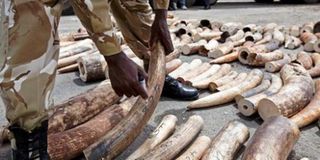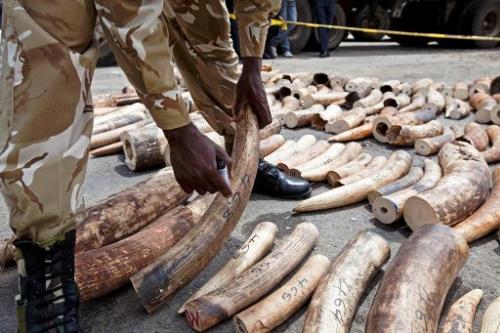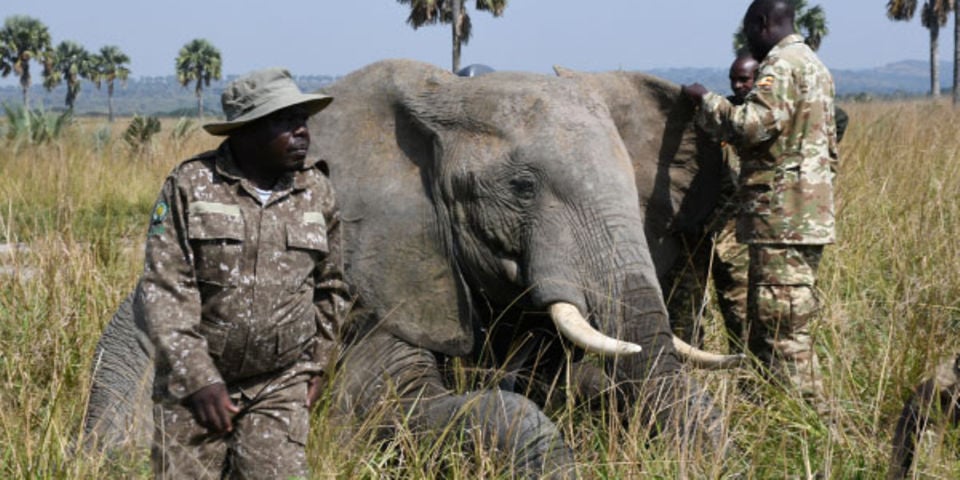Prime
Joblessness, allure of bush meat accelerate poaching

A soldier displays ivory impounded from traffickers in Kampala. A recent report by the UN Office on Drugs and Crime, revealed that poaching of rhinos and elephants was on the rise. The report detailed that crime gangs in East Africa fuelled by profits in the illicit trade threaten the existence of wildlife. PHOTO/ COURTESY
What you need to know:
Poachers are using modern technology in bush meat business, which experts attribute to high rate of unemployment, ignorance, cultural beliefs and rush for quick money
In June, through its East African Wildlife Journalism Project, Earth Journalism Network together with conservation groups launched WildEye East Africa, a geo-mapping tool that enables and allows journalists and policy makers in the East African region to track and share data on court cases and convictions related to wildlife crimes.
This was aimed at addressing lack of data on criminal activity, something that had thwarted reporting of illegal wildlife trade, a major challenge facing crime reporters and investigators.
According to conservationists, the unprecedented increase in wildlife crime across East African countries continues to frustrate conservation efforts and threaten hundreds of animal species in the region.
World Wildlife Fund (WWF) says Wildlife crime is a big business run by “dangerous international networks, where wildlife and animal parts are trafficked much like illegal drugs and arms.”
The trade is facilitated by poachers, traffickers and highly-organised criminal syndicates, who ruthlessly pursue profit at any cost to meet consumer demand.
Experts from conservation movements and journalism organisations say that apart from threatening wildlife, the illegal trade in bush meat and animal products has also led to outbreak of viral diseases such as Ebola, which have claimed lives of people.
Arrests, losses
Daniel Ndizihirwe, the wildlife and protected areas manager at WWF Uganda, says culture is one of the drivers of wildlife trafficking. “Communities neighbouring protected areas get bush meat from forests and use it for magic and curing disease,” says Ndizihirwe.
Other drivers include agricultural encroachment, which comprises of livestock grazing in protected areas and high levels of poverty in communities near protected areas. He adds that commercial bush meat is highly concentrated in areas around parks of Queen Elizabeth and Murchison Falls.
The Karuma Canine Unit set up by Uganda Wildlife Authority to improve investigations of wildlife cases in August seized 69 kilogrammes of ivory, 6six kilogrammes of pangolin scales, 3.5 kilogrammes of hippo teeth, and 155 kilogrammes of bushmeat. Fifteen people were arrested and arraigned in the courts of law for perpetrating the crime.
A survey that was funded by USAID to support East African states achieve their mandate of conserving resources between November 2020 and May 2021, highlighted wildlife species on high demand; ungulates (kobs, buffalos and herbivorous animals) at 81 percent, primates at 7 percent, rodents at 5 percent, birds at 3 percent carnivores 3 percent, and pangolins at 1 percent.
Top 10 consumed species include Dik dik, buffalo, Impala, Wildebeest, bush pig, warthog, zebra, gazelles, eland and hartebeest.
The survey also showed that bush meat is available anytime on demand across the region. Uganda led the race with 83 percent compared to Tanzania’s 68 percent and Kenya’s 60 percent.
Primary means of transportation of bush meat include motorcycles, foot, public vehicles such as buses and private vehicles.
According to the 2021 annual report by Foundation Segré, which promotes humanitarian, scientific, educational, artistic and environmental projects, Tanzania once had one of the largest elephant populations in Africa, but industrial-scale elephant poaching wiped out approximately 60 percent of between 2009 and 2014.
Poachers are using modern tech
Kenneth Kimitei, a landscape ecologist for the Tsavo Mkomazi, says according to data recorded by scouts, poachers are using modern technology in bush meat business. He attributes the trade to high rate of unemployment, ignorance, cultural beliefs and rush for quick money.
Lead players in the syndicate of the bush meat are informers, who connect to different players such as middlemen, brokers, transporters, buyers, sellers and consumers.
Data from World Bank shows that Kenya has lost more than half of its wildlife resources over the last three decades.
It explains that competing natural resource utilisation, escalating human-wildlife conflicts, and systematic poaching of elephants and rhino and the subsequent trafficking of wildlife products, continue to threaten Kenya’s wildlife.
Dr Daniel P Mdetele, an official at Wildlife Trade-One health TRAFFIC International, links bush meat trade and consumption to increased cases of zoonotic diseases such as Anthrax, brucellosis, rift valley fever and rabies, which have claimed lives in over the years.
“Wildlife harbours zoonotic disease pathogens. The microorganisms that cause most of these diseases are always in wild animals, but because these animals have high levels of resistance, they can live with the pathogens. Once we get into contact with wildlife, through different blood, meat, we automatically get the disease,” says Ndihizirwe from WWF Uganda.
Low enforcement thwart efforts
A surge in wildlife trafficking means declining wildlife species, ecosystem malfunctioning, shrinking of tourism industry, loss of cultural heritage, economic crisis and increased disease outbreaks.
Mitigation options include effective management through multi-structural governance, national bans of bush meat trade and consumption, protection of populations at higher risk of exposure, awareness creation, alternative livelihoods and enforcement among others.
WWF is working with communities around protected areas to put in place alternative livelihood options so that communities do not look at poaching as the only source of livelihood.
“We have supported 10 groups that used to poach and because of sensitisation, they stopped poaching. Groups are made of men who are reformed poachers,” says Ndihizirwe.
He says WWF engages communities and agree on suitable enterprises such as include commercial bee keeping that they can undertake and support them.
National and transboundary efforts to keep wildlife trafficking in check have been thwarted by poor enforcement.
Evaluate strategies
The World Conservation Society (WCS) country director, Dr Simon Nampindo, urges stakeholders to adopt a multi-sectoral approach to leverage their interlinkages. “Evaluate efforts from time to time to determine whether we are progressing or regressing,” he said
Isaac Kirya, the WCS manager Illegal Wildlife Trade, says there is need for countries to strengthen their criminal justice systems, to ensure that poachers are prosecuted.
Since 2020, perpetrators of wildlife crimes have employed online technology to communicate and make transactions, a development that is challenging the existing skills of law enforcers.
Government has trained wildlife law enforcement officers on mobile forensic investigations to enhance in-house investigation curb illegal wildlife trade.
“We have intelligence, investigations and prosecution arms. We have built capacity over time and we work with other agencies of government through the National Wildlife Crime Coordination Task Force,” explains UWA’s communications manager Hangi Bashir.





